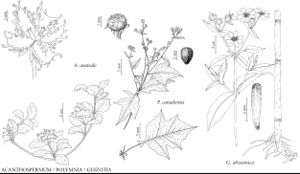Acanthospermum
Pl. Rar. Hort. Monac. 2: plate 53. 1820.
| Taxon | Illustrator ⠉ | |
|---|---|---|
 | Acanthospermum australe Polymnia canadensis Guizotia abyssinica | Barbara Alongi Linda Ann Vorobik Yevonn Wilson-Ramsey |
Annuals (sometimes persisting), 10–60 (–120) cm. Stems erect to ± prostrate (repeatedly “forked”). Leaves cauline; opposite; petiolate or ± sessile; blades mostly elliptic to deltate, rhombic, or ovate, sometimes lyrate, ultimate margins entire or toothed, faces usually pilosulous to sericeous or scabrellous, sometimes glabrate or glabrescent, usually glanddotted. Heads radiate, 1 (–3) in “forks” of branches (terminal, appearing axillary by sympodial growth). Involucres ± hemispheric, 3–5 mm diam. (becoming ± rotate in fruit). Phyllaries persistent (outer) or falling, 10–13 in 2 series (outer 4–6 herbaceous, inner 5–8 each investing a ray ovary, enlarging in fruit to form a perigynium, shed with enclosed cypsela). Receptacles convex, paleate (paleae cuneate to spatulate, ± conduplicate or flattish, membranous). Ray-florets 5–8, pistillate, fertile; corollas yellowish (tubes shorter than to equaling laminae, laminae ovate to elliptic or linear). Disc-florets 3–8 (–12+), functionally staminate; corollas yellowish, tubes shorter than funnelform or campanulate throats, lobes 5, deltate. Cypselae each enclosed within and shed with an often hardened, ± prickly perigynium (the ultimate “fruits” plumply ellipsoid to fusiform, or ± compressed); pappi 0 or rudimentary. x = 11.
Distribution
Introduced; mostly tropical to warm-temperate New World, also in Old World
Discussion
Species 6 (3 in the flora).
Selected References
Key
| 1 | Fruits 7–9+ mm, 5–7-ribbed, terminal spines 0 | Acanthospermum australe |
| 1 | Fruits 2–6 mm, 3-ribbed or not notably ribbed, terminal spines 2 | > 2 |
| 2 | Leaf blades rhombic-ovate to obovate, (20–)40–120(–150+) mm; fruits not notably ribbed, prickles ± scattered | Acanthospermum hispidum |
| 2 | Leaf blades ovate to lyrate, 10–30(–45) mm; fruits usually 3-ribbed, prickles mostly along 2 ribs and around apices | Acanthospermum humile |